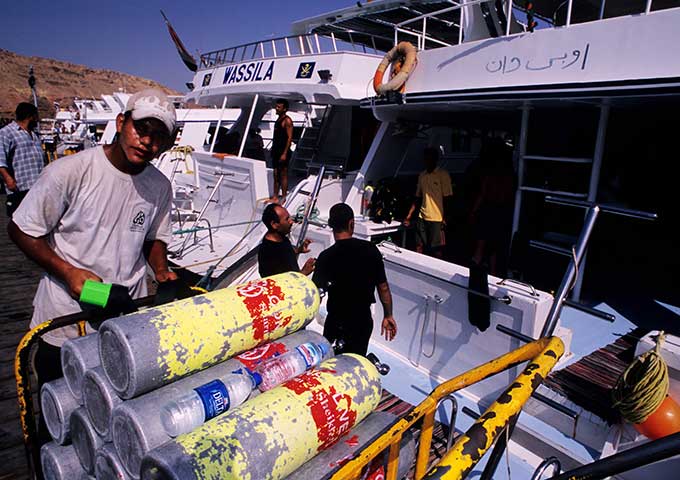Diving from a boat is an adventure in itself. For many dive sites, boats are the only way to get there. Boats come in all shapes and sizes, depending on the number of people it needs to carry, whether or not you will live aboard, and the distance needed to travel. Distance to a dive site can vary considerably so whilst a 10-minute ride in a 12ft Rib may be used in the Dominican, a 5 hour ride in a 40ft Live-Aboard may be used on the Great Barrier Reef.
Although the idea of boarding a boat and setting off to a remote dive site and diving into the unknown is something we all dream about, the reality is that most of us will use the expertise, knowledge and equipment of local dive centres and operators. This shouldn’t however detract from your responsibilities as a diver to think and prepare for the type of diving you are about to embark on.
Wherever you chose to dive around the world, you can be sure that there will be many factors that differ considerably. However, there are very general guidelines you should consider before diving, that apply no matter where you are:
- If you suffer from seasickness and are going to take medication, make sure you start the medication in good time. Don’t leave it until you start feeling unwell.
- A good previous nights rest is essential, and then you can arrive early. This avoids anxiety and the consequent worry of whether you’ve forgotten anything. It also means you get a feel for how the trip is organized and are able to ask any questions you may have in a relaxed unhurried manner.
- A good breakfast is a good idea (however, don’t eat a huge breakfast if you’re going to be diving 10 minutes later – you need time to digest the food to prevent the possibility of stomach cramps occurring.).
- Make sure you are going to be warm enough, travelling to/from the dive site.
- Never board a vessel until you are told to do so.
- The Captain of the boat is responsible for your safety, so always follow his instructions.
- If you are stowing your equipment on the boat, then before the boat gets underway, be sure it is all stowed safely away. Be especially careful to secure your tanks and weights, and make sure that neither is liable to fall over or drop from any height.
- Make sure you know exactly which is your equipment. If it’s your own equipment then you should have marked it in some way.
- Drink plenty of water.
- If you have a dive bag with you, get into the practice of repacking it whenever you take anything out of it. Never leave an item lying around. A loose item on a boat is a danger to all, especially when the sea is a little rough.
- If your intention is to have an equipment bag to keep stuff dry, then have a spare bag to store your wet equipment.
- Always keep one hand free on a boat, to steady yourself.
- Always listen to dive briefings. If you are uncertain, ask. Remember that divers have their own language, so make sure you understand it.
- Always plan your dive and then dive your plan.
- Know where first aid and oxygen are located. Even if you don’t know how to use it, know where it is – in case you are asked to get it – quickly.
- Ensure you are conversant with buddy checks and start performing the check early. Be especially diligent if you are diving with a stranger.
- Do not be afraid of going through basic hand signals and emergency procedures with your buddy. Remember – you may have come from opposite sides of the world and their idea of safe, may not be the same as yours.
- Ensure you are familiar with decompression procedures.
- Walking with fins is difficult and dangerous. Put them on as close to the entry point as possible.
- Entry methods from boats can also vary, though the Backward Roll and the Giant Stride are the most commonly used.
- Before entering the water, make any visual references you can.
- Once in the water, if possible re-establish those references, and always note the direction you are facing in relation to the direction of the boat before you descend.
- Be aware that with some boat diving in deep water, you may have no visual reference to depth other than an anchor or buoy line. Remember that you will want to surface near this line.
- In deep water, your buoyancy control needs to be good, so keep an eye on your gauges.
- Ensure you are familiar with the procedures of deploying an SMB (surface marker buoy), if you are using one. This could be the only way of indicating to the boat, your surfacing location.
- Exits from the water (on a boat), are usually relatively graceful, via steps or a board at the rear. However, on a rib it can be the opposite, as you sometimes need to be hauled in over the side.
- You don’t ever want to get left behind so, ensure there will be a roll call at the end of your dive.
- Tipping – depending on where you are, tipping can sometimes be common practice. Ensure you know beforehand whether this is the case for your location.
- Remember the 24-hour rule. Don’t fly within 24 hours of diving.
Also remember that the effects of continuous multiple diving are still not an exact science. If diving over a prolonged period, take a day out in the middle. And consider erring towards shallower dives toward the end of your diving holiday.













